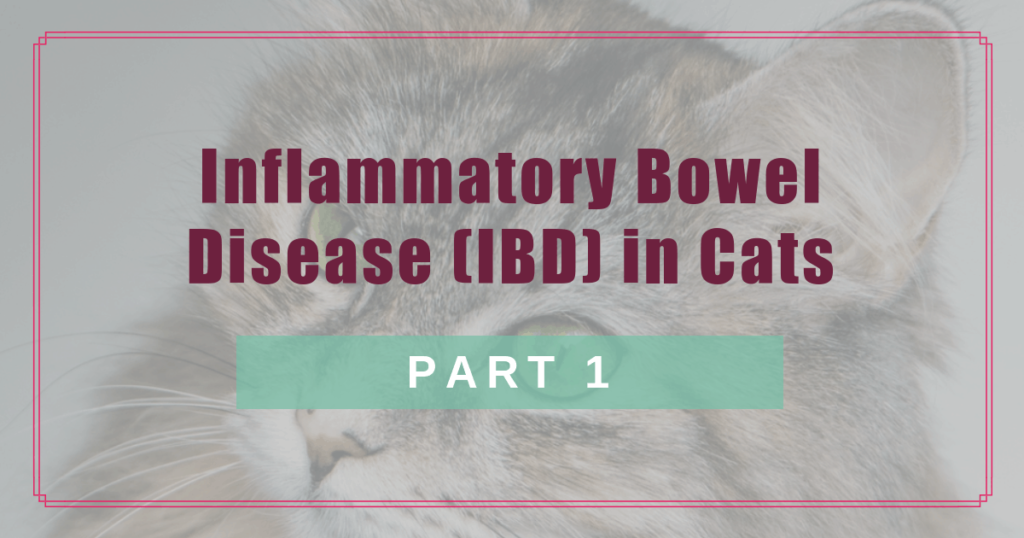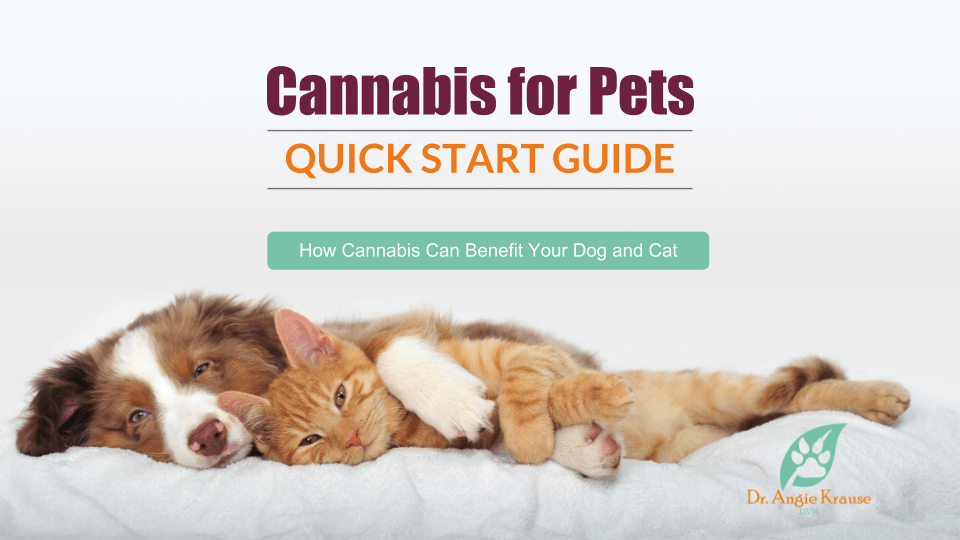Inflammatory Bowel Disease (IBD) in Cats: Part 1

Inflammatory Bowel Disease (IBD) in cats is common and can be challenging to manage. I have created a two part series to help empower you to take a thorough and holistic approach to this disease. In the first part I will cover the symptoms of IBD along with an in-depth discussion of navigating the tests and procedures that are used to confirm a diagnosis of IBD. In part two you will learn how to use diet, natural remedies and if needed pharmaceuticals to achieve the best results for your kitty.
Symptoms:
IBD has a wide spectrum of severity. Some cats have very mild and intermittent symptoms and may not require treatment, while other cats suffer from life threatening disease. Here is a list of symptoms that can be associated with IBD:
- Weight loss (for some cats, this is the only symptom)
- Vomiting
- Diarrhea
- Urinating or defecating outside box
- Ravenous appetite
- Eating non-food objects
Many of these symptoms are non-specific and can be associated with other disease such as hyperthyroidism, diabetes, kidney disease and even cancer. In the next section we will discuss how to proceed with diagnostics to ensure we rule out these other types of disease.
Diagnostics:
There is A LOT of diagnostic testing when it comes to getting a definitive diagnosis of IBD in kitties. You may not have the resources to complete them all. That is 100% okay. I will discuss treatment alternatives, if the test is not in your budget.
Round 1:
- Blood chemistry. These panels vary in depth but generally contain liver enzymes, kidney function indicators and electrolytes. This test is going to rule out other common diseases like kidney disease or diabetes.
- Total T4. This a thyroid function test and will help rule out hyperthyroidism. This disease can look EXACTLY like IBD.
- Complete Blood Count (CBC). This test looks at the number red blood cells, white blood cells and platelets. This test may discover other or more serious disease processes.
- Urinalysis. This helps us test kidney function and rule out concurrent urinary tract disease.
These tests are usually the most preliminary tests. The sum of these tests will generally cost around $250. If you are on a tight budget, opt to skip the CBC and urinalysis. Your veterinarian can work with you in selecting the blood tests that fit your budget.
If the previous tests are normal or do not explain your cat’s symptoms here are the next steps:
Round 2:
- Abdominal ultrasound. This is a non-invasive test that requires your cat’s belly to be shaved so that the abdominal organs can be visualized via sonogram. This will help screen for disease of the liver, pancreas, kidneys and adrenal glands. This also allows us to visualize the bowel loops and their thickness. When the intestinal walls are thickened, we suspect that they are inflamed. The ultrasound also allow us to visualize the lymph nodes associated with the bowels. When these lymph nodes are enlarged, it is an indication of inflammation or cancer.
Generally an abdominal ultrasound is between $250-$500. Depending on the severity of your cat’s symptoms, you may elect to stop here and pursue treatment. If your cat’s symptoms are severe or you would like to keep climbing the diagnostic ladder here are the next steps.
Round 3:
- Gastrointestinal Panel from Texas A&M University. This blood test looks specifically at how the intestines are absorbing nutrients. It also looks at the function of the pancreas. Many cats with IBD also have some degree of inflammation. I often add this test on to round 1 diagnostics when I have vomiting kitty. There are a couple nutrients that we can give to help offset what the intestines are not absorbing. As a result, this test can really help guide our treatment.
- Endoscopy. This is used when we want more definitive answer. During this test, your cat is anesthetized and a camera is put down their esophagus into their stomach and a small portion of the intestines. Here they can visualize the lining of the gastrointestinal tract and can take samples to analyze. These tissue samples will help categorized the type of inflammation. This can also be used to guide treatment.
The Gastrointestinal Panel is around $350 but can be broken down into individual tests. Generally endoscopies run around $1,500-$2,000. This is where the majority of pet parents stop with diagnostics. By now, we often have the answers we need to proceed with successful treatment. However, some cases require more definitive answers. On to the next round!
Round 4:
- Abdominal Exploratory. The tissues samples we took on the endoscopy were only part of the intestines. To obtain a DEFINITIVE diagnosis, we must take a full thickness sample of the intestines. This requires us to open the abdomen and remove a small portion of bowel in a few locations. This is generally reserved for cases in which we suspect intestinal lymphoma or if kitty is not responding to treatment.
Phew! Are you exhausted yet? We are on the home stretch!
This discussion would not be complete without mentioning intestinal lymphoma. This is the scary part of IBD in kitties. Sometimes IBD and intestinal lymphoma look exactly the same. On occasion IBD can lead to intestinal lymphoma. Any spot in the body that has chronic inflammation is more prone to more serious disease.
Here is my advice when thinking about intestinal lymphoma. If your veterinarian suspects intestinal lymphoma, do an endoscopy if you can afford it. Otherwise, do your best to treat your cat’s IBD. That is literally all you can do. Remember there are millions of cats that live with IBD their entire lives and never develop lymphoma.
Okay, enough scary stuff for now. In part 2, we will discuss diet and other treatments. This is the good stuff!
Does your kitty have IBD? How much diagnostics did you do?
Sending you are your kitties love!


By signing up for our newsletter, you consent to recieve emails and SMS messages for marketing purposes, and agree to our Privacy & Cookie Policy. We will never sell/share your information!

Hey there, I’m Dr. Angie
I help empower pet owners to become medical advocates for their pets.
Let's get started!
What would you like to read?










8 thoughts on “Inflammatory Bowel Disease (IBD) in Cats: Part 1”
My 11 yr old male cat has pancreatitis or IBD! Both are similar! In any case he wasn’t eating, vomiting, very lethargic! Switched him to hills science diet prescription canned cat food I/d chicken and vegetable stew! That did the trick!! He also had trouble using his litter box! Gave him Uromaxx liquid everyday and his blood in the urine & E. coli went away! I mix this in his canned food everyday! A miracle product! Also giving him Phytomaxx CBD oil everyday and for 5 months now he’s like a kitten again!!!
Hi Ronald,
You are amazing for sharing you and your cats experience! It is not an easy task to find a diet that a kitty with both IBD and pancreatitis will eat (and without vomiting or diarrhea). Well done, and again, thank you for sharing!
Warmly,
Claire
Thank you so much Dr Angie for this info. My cat has all the symptoms and was constantly hungry and lost so much weight down to bones. But after reading this I got the food & pills recommended (prednisone and the Royal Canin) and so far he is responding so much better– hes not begging for food after two hours anymore and I feel the food is seeping in and he is getting nutrients. Thanks so much for the articles!
Hi David,
Wow! What an amazing update. We are so thrilled that Dr. Angie’s suggestions have helped your boy.
Please keep us posted!
Warmly,
Claire
Thank you so much for such a thorough look at IBD in cats (I read your second post, too). My poor boy has had a rough year and a half, kicked off with a subtotal colectomy. He had his ultrasound today and the little bit of his colon left looks to be extremely inflamed. We’re trying budesonide (after diet change, allergy testing, regular probiotics, and intermittent courses of metronidazole that have stopped working). This blog series has made me feel much better about trying a corticosteriod treatment before I pursue invasive testing. Thank you, again.
Hi Teresa,
You are doing such a great job with your boy!
I’m so glad that Dr. Angie’s blog has helped provide you comfort with the ways in which you are advocating for you kitty.
Will you keep us posted?
Warmly,
Claire Primo
Veterinary Nurse
Boulder Holistic Vet
My 13 year old kitty had an abdominal ultrasound yesterday and I was wondering if you could help me understand something. Here are the significant parts of the report:
“No evidence of obstructive disease but a focal segment of small bowel in the mid-cranial abdomen exhibits concentric wall thickening (measured serosal-luminal wall thickness of ~6-9 mm) with marked distortion of wall layering; measured wall thickness of ~2.8-4.0 mm in unaffected small bowel segments.
Multiple mildly to moderately enlarged and irregular mesenteric LN visualized in the mid-cranial abdomen.”
In your description of abdominal ultrasound above, you mention increased wall thickness as an indication of inflammation. Does this report indicate inflammation or progression to lymphoma? I have been treating her IBD with diet and have finally gotten her on a raw, single protein diet that she seems to tolerate very well but she hasn’t gained any weight. She is quite thin and always hungry.
My regular vet hasn’t sen these results yet and the specialty center I went to for the ultrasound was extremely aggressive about wanting to give her IV hydration despite the fact that she wasn’t dehydrated as well an anti-nausea drugs when she wasn’t nauseated. These actions made me question the severity that they indicated. Thank you so much for any advice you can give me.
Hi Holly! I am so glad you are looking into your kitty’s symptoms. The ultrasound report does not distinguish the difference between IBD and lymphoma. It may be time to consider a biopsy to get a definitive diagnosis. Let me know what you find!
Warmly,
Dr. Angie